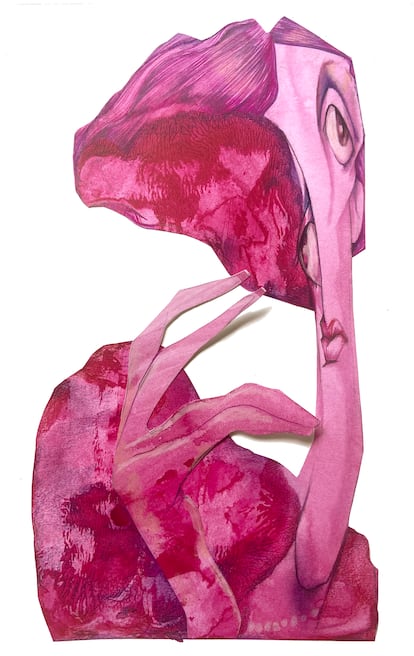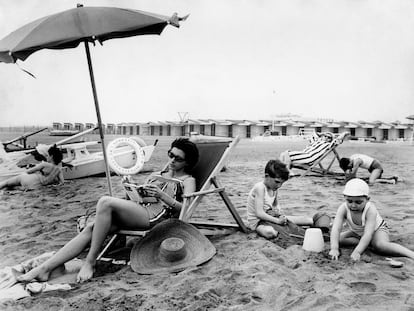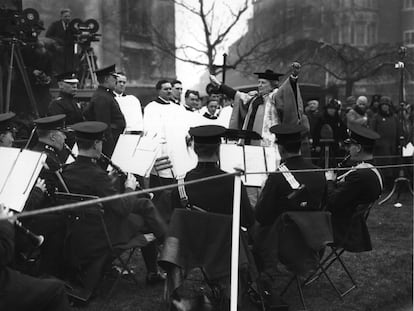Virginia Woolf, an entire life in a notebook
The writer’s monumental diaries have been published in five volumes. In them, she outlines her novels and essays, mixes genres and records her moods… including suicidal thoughts

The modern self and its restlessness can find fertile ground in diaries. It’s hard to imagine that one can fully understand the complex personality of 19th and 20th century artists without them… especially since they used the medium to give birth to their creations. Between fiction and manifesto, a diary isn’t merely a vehicle for introspection and emotional release. For artists, it’s a way of looking at themselves in the mirror.
One particularly impressive corpus – more than 3,000 pages long – is André Gide’s diary.
The French writer – who won the Nobel Prize for Literature in 1947 – was greatly admired by Virginia Woolf. In her own personal papers, the British writer wrote, in November of 1939, “how does one compete with Gide’s concentration & lucidity while writing your [own] diary?”
Other famous diaries have been penned by figures such as the Portuguese poet Fernando Pessoa, whose writings show his alienation from the world; Franz Kafka, whose disappointing intimate experiences are intertwined with his literary defeats; the shocking and delicious 1927 Diary, by Katherine Mansfield, which her husband edited to share with the world. Or the unpublished novel and musings that Irène Némirovski kept in her bag, next to an orange, before perishing in the Holocaust.
From Mansfield’s short stories and diary, Woolf – who wrote iconic novels such as To the Lighthouse and extended essays including A Room of One’s Own – learned to include everyday life in her writing and to link what one observes with what one feels. In A Writer’s Diary – published in 1953, 12 years after her death – one can attest to how she balances the weakness of the spirit with its vitality. Just as she looked at the precipice of the modern world (and at her own existence), Anaïs Nin – a French-born American diarist – noted that the diary “is my hashish and my opium pipe… it drives me to write almost at the same time as I live.”
To this incomplete list would be added The Business of Living, by the Italian writer Cesare Pavese. His diary – born in October of 1935 – ended just a few days before the author’s suicide, in 1950. Similar circumstances occur with Virginia Woolf’s diary, which she completed on March 24, 1941, just four days before she filled her pockets with stones and took her own life, throwing herself in the River Ouse, in East Sussex.
Other dramatic diaries include War: A Memoir (1945), by the French novelist Marguerite Duras, or the solemn Diary, by Witold Gombrowicz, who wrote – between utopia and disenchantment – to save himself, “for fear of degradation and total collapse between the waves of trivial life.” He also admitted to have written “with reluctance,” because “insincere sincerity” tired him. The Polish absurdist often asked the eternal question: Who am I writing for?
Later would come the stark Patricia Highsmith: Her Diaries and Notebooks (1941-1995), published posthumously. She died the same year that her personal writings stopped – they were full of personal demons and powerful opinions. Similarly turbulent works were
Alejandra Pizarnik’s Diary: The Temptation of Failure; Julio Ramón Ribeyro’s Personal Diary; Fickle Dietary, by Enrique Vila-Matas, or The Diaries of Emilio Renzi, by Ricardo Piglia, in which the Argentine author chronicles his shadow self.
Added to this collection of publicly-available diaries are the texts written over the course of 26 years by Virginia Woolf. Crammed into 30 notebooks that are preserved in the Berg Collection of the New York Public Library, they were released in five volumes, in a commendable effort by Anne Olivier Bell, the legendary British art scholar. Across the five edited diaries – released between 1979 and 1985 – the reader can glimpse common themes, as well as the hint of complicity in the intertextual crossroads. Bell – in addition to making the original English editions accessible – also enriched them with an encyclopedic critical apparatus for literary scholars.
Through these pages, the feminist who fought for women’s rights feels free… albeit not fully emancipated. The reader meets the author and her sister, Vanessa, both members of the Bloomsbury Group – a collective of British writers, philosophers and artists who pushed for modern attitudes in the first-half of the 20th century. Other characters are John Maynard Keynes, Lytton Strachey and E. M. Forster.
In her diaries, the London urbanite attempts to come to terms with the existence of the natural landscape, which, through her novels, she depicts in post-impressionist ways, with a marked propensity for color. At times, the loyal wife foresees her end… while also noting that her husband, Leonard – who helped publish Virginia’s novels – is working in the garden, pruning flowers.
Apart from the familial and social network – which makes up a large part of the Diaries – Woolf also uses the pages to analyze her moods and the evolution of her personality. “It amuses me to discover how a person develops,” she wrote, in December of 1919. The divine banality of daily life is also dissected in her notebooks, while there’s also correspondence that preceded the drafting of Modern Fiction – a famous essay by Woolf that acted as a guide for writers of modern fiction, encouraging them to write what they feel and observe: “The mind receives endless impressions… trivial, fantastic, evanescent…”
In all five editions, the reader will be able to notice that Woolf doesn’t discriminate between genres when it comes to writing. In this way, her diaries and letters maintain a healthy dialogue surrounding the conception and writing of her great novels and famous essays. She treated these projects as defenses against the ravages of life.
At one point, in September of 1922, she unequivocally dismisses James Joyce, writing: “I have finished Ulysses & I think it’s a failed work. I think he doesn’t lack talent… [but the book] is nauseating, pretentious. It’s vulgar.” She’s convinced that “a first-class writer respects writing too much to resort to cheating, provocation or tricks.” She inevitably distanced herself from the Irish writer. In her diaries, she also quoted T.S. Eliot, who supposedly told her that, after writing Ulysses, Joyce had “destroyed the whole of the 19th-century novel. It left [him] with nothing to write another book on.”
A few months before this – before the publication of Jacob’s Room (1922), her third novel – she noted: “I think that, at the age of 40, I’ve discovered how to say something with my own voice.” When looking at the genesis of Mrs. Dalloway (1924), she scribbled about her intention to turn it into “a study on madness and suicide” – concepts that would form part of her stormy intimacy. “What do I feel about my writing?” she wrote in June of 1923. “Dostoevesky said that you have to write from the depths of feeling. Should I do that? Or should I write stories with words, loving them as I so love them?”
When referring to one work she published, she scolds herself, saying that “there’s an excess of ideas.” She is also quite self-aware: “I live totally within my imagination, I depend on those flashes of thought that assail me as I walk… things that go around in my head, as in a perpetual festive parade.” There are worries about critics – who may reproach her – as well as moments of elation: “Now I can write, write and write, the great feeling of happiness in the world.” And, of course, there’s the recognition of language’s fallibility: “All these words cannot express what I want to say,” she lamented, in April of 1935.
In September 1926, Woolf records a moment of depression. It’s not the first, nor the last. In October 1934, she would write: “I’m low in morale. It’s the end of the book. I’ve searched in [past diaries] and I have found the same sadness after [writing] The Waves. After finishing To the Lighthouse, I remember contemplating suicide.” This is the same woman who, in April of 1927, wrote happily under the Sicillian sun: “I would like to travel all my life, wandering among the ruins and watching the schooners arrive. I would prefer to write, but perhaps it’s better to imagine books.” In December of 1929, while looking through the antique shops in Rome, she confesses that “the variations of each phrase and the unsuccessful attempts” in the creative process of The Waves have turned her notebook “into a lunatic’s dream.”
On May 2, 1932, she records that “a lobster has landed in the olive tree.” And, on May 18, she’s “sitting by an open window in the bay where Shelley (the poet) drowned.” She adores Greece and says she wants to buy a big Spanish mule, yet her fondness for London underlies every comment en route.
The diaries contain all sorts of images, from a lighthouse seen through foggy glass, to dragonflies floating in the air. There’s the anguish of glimpsing dementia, the joy of drinking coffee on a balcony above lemon trees and anxiety about paying the rent in Tavistock Square. Frustration about trying to combat social injustice with a text, happiness about strong book sales and doubt about whether a character should have been written differently. There’s the sighting of a German bomber, or the assumption that, following the publication of A Room of One’s Own, the critics will hint that she’s a lesbian. “A mind… [is] life itself in its passing,” she notes, in May of 1929. Her diary is the feverish exercise of translating the stream of consciousness onto a page.
“Writing must be a daily pleasure,” she reminds herself, in December of 1940, near the end of her life. By this point, she’s in the cold winter (of both the seasons and her time on Earth). The diary provides her with a continuous exercise in writing, one that goes beyond the steady composition of her novels. A space opens up that allows writing and intimacy to go hand-in-hand.
Woolf dedicated herself to keeping her diary until end of her days, driven by a need to record her entire life in 30 notebooks “not so much to tell the truth as to justify her state of mind,” as she wrote in the collection Memoirs of a Novelist, referring to Frances Ann Willatt – the fictional writer that Woolf invented to explore the nature of the biography. One of her biographers – Lyndall Gordon – points out that the character is clearly based on Woolf herself.
Sign up for our weekly newsletter to get more English-language news coverage from EL PAÍS USA Edition
Tu suscripción se está usando en otro dispositivo
¿Quieres añadir otro usuario a tu suscripción?
Si continúas leyendo en este dispositivo, no se podrá leer en el otro.
FlechaTu suscripción se está usando en otro dispositivo y solo puedes acceder a EL PAÍS desde un dispositivo a la vez.
Si quieres compartir tu cuenta, cambia tu suscripción a la modalidad Premium, así podrás añadir otro usuario. Cada uno accederá con su propia cuenta de email, lo que os permitirá personalizar vuestra experiencia en EL PAÍS.
¿Tienes una suscripción de empresa? Accede aquí para contratar más cuentas.
En el caso de no saber quién está usando tu cuenta, te recomendamos cambiar tu contraseña aquí.
Si decides continuar compartiendo tu cuenta, este mensaje se mostrará en tu dispositivo y en el de la otra persona que está usando tu cuenta de forma indefinida, afectando a tu experiencia de lectura. Puedes consultar aquí los términos y condiciones de la suscripción digital.










































